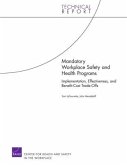Quality and Safety in Women's Health
Herausgeber: Ivester, Thomas; Gluck, Paul A.; Weiss, Patrice M.
Quality and Safety in Women's Health
Herausgeber: Ivester, Thomas; Gluck, Paul A.; Weiss, Patrice M.
- Broschiertes Buch
- Merkliste
- Auf die Merkliste
- Bewerten Bewerten
- Teilen
- Produkt teilen
- Produkterinnerung
- Produkterinnerung
Designed for providers of women's healthcare, this guides those implementing QI programs with emphasis on Obstetrics and Gynecology practice.
Andere Kunden interessierten sich auch für
![Occupational Safety and Health for Public Safety Employees Occupational Safety and Health for Public Safety Employees]() Tom LatourretteOccupational Safety and Health for Public Safety Employees35,99 €
Tom LatourretteOccupational Safety and Health for Public Safety Employees35,99 €![Mandatory Workplace Safety and Health Programs Mandatory Workplace Safety and Health Programs]() Tom LatourretteMandatory Workplace Safety and Health Programs21,99 €
Tom LatourretteMandatory Workplace Safety and Health Programs21,99 €![Thermal-Hydraulic Principles and Safety Analysis Guidelines of Pwrs and Ipwr-Smrs Thermal-Hydraulic Principles and Safety Analysis Guidelines of Pwrs and Ipwr-Smrs]() Thermal-Hydraulic Principles and Safety Analysis Guidelines of Pwrs and Ipwr-Smrs161,99 €
Thermal-Hydraulic Principles and Safety Analysis Guidelines of Pwrs and Ipwr-Smrs161,99 €![Child Workers and Industrial Health in Britain, 1780-1850 Child Workers and Industrial Health in Britain, 1780-1850]() Peter KirbyChild Workers and Industrial Health in Britain, 1780-185028,99 €
Peter KirbyChild Workers and Industrial Health in Britain, 1780-185028,99 €![Levi's Children Levi's Children]() Karl SchoenbergerLevi's Children11,99 €
Karl SchoenbergerLevi's Children11,99 €![Harnessing Labour Confrontation Harnessing Labour Confrontation]() Peter S McInnisHarnessing Labour Confrontation47,99 €
Peter S McInnisHarnessing Labour Confrontation47,99 €![Marxism and Historical Practice (Vol. II) Marxism and Historical Practice (Vol. II)]() Bryan D PalmerMarxism and Historical Practice (Vol. II)35,99 €
Bryan D PalmerMarxism and Historical Practice (Vol. II)35,99 €-
-
-
Designed for providers of women's healthcare, this guides those implementing QI programs with emphasis on Obstetrics and Gynecology practice.
Produktdetails
- Produktdetails
- Verlag: Cambridge University Press
- Seitenzahl: 234
- Erscheinungstermin: 1. März 2019
- Englisch
- Abmessung: 246mm x 189mm x 13mm
- Gewicht: 462g
- ISBN-13: 9781107686304
- ISBN-10: 110768630X
- Artikelnr.: 49562000
- Herstellerkennzeichnung
- Libri GmbH
- Europaallee 1
- 36244 Bad Hersfeld
- gpsr@libri.de
- Verlag: Cambridge University Press
- Seitenzahl: 234
- Erscheinungstermin: 1. März 2019
- Englisch
- Abmessung: 246mm x 189mm x 13mm
- Gewicht: 462g
- ISBN-13: 9781107686304
- ISBN-10: 110768630X
- Artikelnr.: 49562000
- Herstellerkennzeichnung
- Libri GmbH
- Europaallee 1
- 36244 Bad Hersfeld
- gpsr@libri.de
1. Office safety Ty B. Erickson and Amber D. Masse; 2. Electronic fetal
monitoring and patient safety David Miller; 3. Patient safety in the
outpatient setting Roger Smith and Mark D. Pearlman; 4. Principles for the
safe use of electrosurgery Fidel A. Valea; 5. The obstetric-gynecologic
hospitalist Christopher C. Swain and Alan M. Dulit; 6. Transparency and
disclosure Sandra Koch; 7. Surgical checklists John Wachtel and Abraham
Lichtmacher; 8. What is a high-reliability organization? Joseph C. Gambone
and John P. Keats; 9. Powerful tools for quality improvement John P. Keats;
10. Simulation and drills Shad Deering; 11. Rapid response in obstetrics
Allison R. Durica and Elizabeth S. McCuin; 12. Regulatory and legal
implications Mark S. Defrancesco; 13. Patient safety: a patient's
perspective Pamela K. Scarrow; 14. Safety programs in a community hospital
- evidence-based medicine meets the realities of private practice Holly S.
Puritz; 15. Improving perinatal safety in an integrated healthcare system
Hans P. Cassagnol and Harry Mateer; 16. Fatigue and safety Peter A.
Schwartz, James W. Saxton and Maggie M. Finkelstein; 17. Just culture in
women's health services Michael E. Barfield, Margaret Sturdivant and Karen
Frush; 18. Medication safety in obstetrics and gynecology Roseann Richards
and Angela Brenner; 19. Improving patient safety through team training
Christian M. Pettker and Edmund F. Funai; 20. A systems-based approach to
shoulder dystocia safety William A. Grobman; 21. Creating a learning
culture: debriefing and root-cause analysis Nancy Chescheir; 22. Safe
patient handoffs Diana Behling and Bonnie Dattel; 23. Using clinical
scenarios to teach patient safety Dotun Ogunyemi, Bruce B. Ettinger and
Steve Rad; 24. Quality and safety in medical education: implementing a
curriculum of patient safety and quality improvement in medical education
Dotun Ogunyemi.
monitoring and patient safety David Miller; 3. Patient safety in the
outpatient setting Roger Smith and Mark D. Pearlman; 4. Principles for the
safe use of electrosurgery Fidel A. Valea; 5. The obstetric-gynecologic
hospitalist Christopher C. Swain and Alan M. Dulit; 6. Transparency and
disclosure Sandra Koch; 7. Surgical checklists John Wachtel and Abraham
Lichtmacher; 8. What is a high-reliability organization? Joseph C. Gambone
and John P. Keats; 9. Powerful tools for quality improvement John P. Keats;
10. Simulation and drills Shad Deering; 11. Rapid response in obstetrics
Allison R. Durica and Elizabeth S. McCuin; 12. Regulatory and legal
implications Mark S. Defrancesco; 13. Patient safety: a patient's
perspective Pamela K. Scarrow; 14. Safety programs in a community hospital
- evidence-based medicine meets the realities of private practice Holly S.
Puritz; 15. Improving perinatal safety in an integrated healthcare system
Hans P. Cassagnol and Harry Mateer; 16. Fatigue and safety Peter A.
Schwartz, James W. Saxton and Maggie M. Finkelstein; 17. Just culture in
women's health services Michael E. Barfield, Margaret Sturdivant and Karen
Frush; 18. Medication safety in obstetrics and gynecology Roseann Richards
and Angela Brenner; 19. Improving patient safety through team training
Christian M. Pettker and Edmund F. Funai; 20. A systems-based approach to
shoulder dystocia safety William A. Grobman; 21. Creating a learning
culture: debriefing and root-cause analysis Nancy Chescheir; 22. Safe
patient handoffs Diana Behling and Bonnie Dattel; 23. Using clinical
scenarios to teach patient safety Dotun Ogunyemi, Bruce B. Ettinger and
Steve Rad; 24. Quality and safety in medical education: implementing a
curriculum of patient safety and quality improvement in medical education
Dotun Ogunyemi.
1. Office safety Ty B. Erickson and Amber D. Masse; 2. Electronic fetal
monitoring and patient safety David Miller; 3. Patient safety in the
outpatient setting Roger Smith and Mark D. Pearlman; 4. Principles for the
safe use of electrosurgery Fidel A. Valea; 5. The obstetric-gynecologic
hospitalist Christopher C. Swain and Alan M. Dulit; 6. Transparency and
disclosure Sandra Koch; 7. Surgical checklists John Wachtel and Abraham
Lichtmacher; 8. What is a high-reliability organization? Joseph C. Gambone
and John P. Keats; 9. Powerful tools for quality improvement John P. Keats;
10. Simulation and drills Shad Deering; 11. Rapid response in obstetrics
Allison R. Durica and Elizabeth S. McCuin; 12. Regulatory and legal
implications Mark S. Defrancesco; 13. Patient safety: a patient's
perspective Pamela K. Scarrow; 14. Safety programs in a community hospital
- evidence-based medicine meets the realities of private practice Holly S.
Puritz; 15. Improving perinatal safety in an integrated healthcare system
Hans P. Cassagnol and Harry Mateer; 16. Fatigue and safety Peter A.
Schwartz, James W. Saxton and Maggie M. Finkelstein; 17. Just culture in
women's health services Michael E. Barfield, Margaret Sturdivant and Karen
Frush; 18. Medication safety in obstetrics and gynecology Roseann Richards
and Angela Brenner; 19. Improving patient safety through team training
Christian M. Pettker and Edmund F. Funai; 20. A systems-based approach to
shoulder dystocia safety William A. Grobman; 21. Creating a learning
culture: debriefing and root-cause analysis Nancy Chescheir; 22. Safe
patient handoffs Diana Behling and Bonnie Dattel; 23. Using clinical
scenarios to teach patient safety Dotun Ogunyemi, Bruce B. Ettinger and
Steve Rad; 24. Quality and safety in medical education: implementing a
curriculum of patient safety and quality improvement in medical education
Dotun Ogunyemi.
monitoring and patient safety David Miller; 3. Patient safety in the
outpatient setting Roger Smith and Mark D. Pearlman; 4. Principles for the
safe use of electrosurgery Fidel A. Valea; 5. The obstetric-gynecologic
hospitalist Christopher C. Swain and Alan M. Dulit; 6. Transparency and
disclosure Sandra Koch; 7. Surgical checklists John Wachtel and Abraham
Lichtmacher; 8. What is a high-reliability organization? Joseph C. Gambone
and John P. Keats; 9. Powerful tools for quality improvement John P. Keats;
10. Simulation and drills Shad Deering; 11. Rapid response in obstetrics
Allison R. Durica and Elizabeth S. McCuin; 12. Regulatory and legal
implications Mark S. Defrancesco; 13. Patient safety: a patient's
perspective Pamela K. Scarrow; 14. Safety programs in a community hospital
- evidence-based medicine meets the realities of private practice Holly S.
Puritz; 15. Improving perinatal safety in an integrated healthcare system
Hans P. Cassagnol and Harry Mateer; 16. Fatigue and safety Peter A.
Schwartz, James W. Saxton and Maggie M. Finkelstein; 17. Just culture in
women's health services Michael E. Barfield, Margaret Sturdivant and Karen
Frush; 18. Medication safety in obstetrics and gynecology Roseann Richards
and Angela Brenner; 19. Improving patient safety through team training
Christian M. Pettker and Edmund F. Funai; 20. A systems-based approach to
shoulder dystocia safety William A. Grobman; 21. Creating a learning
culture: debriefing and root-cause analysis Nancy Chescheir; 22. Safe
patient handoffs Diana Behling and Bonnie Dattel; 23. Using clinical
scenarios to teach patient safety Dotun Ogunyemi, Bruce B. Ettinger and
Steve Rad; 24. Quality and safety in medical education: implementing a
curriculum of patient safety and quality improvement in medical education
Dotun Ogunyemi.








